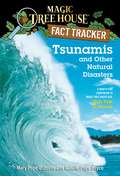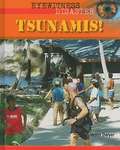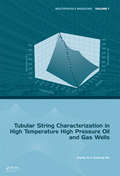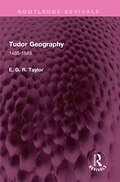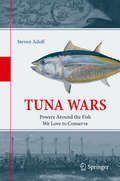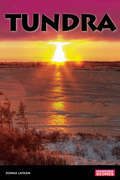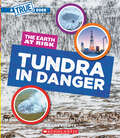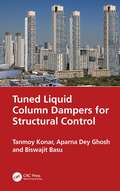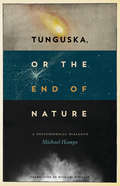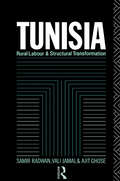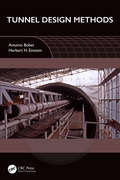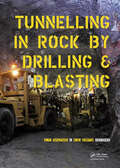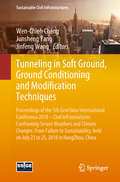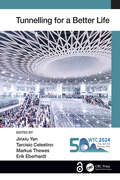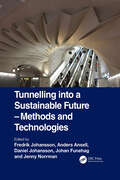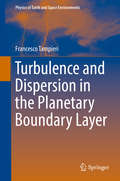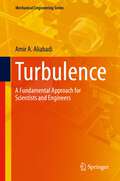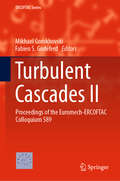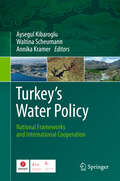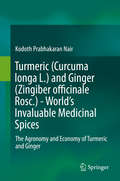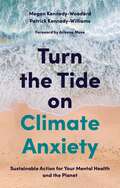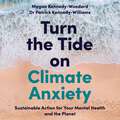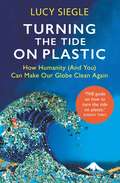- Table View
- List View
Tsunamis and Other Natural Disasters: A Nonfiction Companion to Magic Tree House #28: High Tide in Hawaii (Magic Tree House Fact Tracker #15)
by Mary Pope Osborne Sal Murdocca Natalie Pope BoyceMagic Tree House Research Guides are now Magic Tree House Fact Trackers! Track the facts with Jack and Annie! When Jack and Annie got back from their adventure in Magic Tree House #28: High Tde in Hawaii, they had lots of questions. What causes tsunamis? Who studies earthquakes? How do volcanoes form? What should people do if an avalanche hits? Find out the answers to these questions and more as Jack and Annie track the facts. Filled with up-to-date information, photos, illustrations, and fun tidbits from Jack and Annie, the Magic Tree House Fact Trackers are the perfect way for kids to find out more about the topics they discovered in their favorite Magic Tree House adventures.From the Trade Paperback edition.
Tsunamis!
by Helen DwyerProvides facts about tsunamis, discusses how they are formed, examines where they happen, and includes information on tsunami warnings.
Tubular String Characterization in High Temperature High Pressure Oil and Gas Wells (Multiphysics Modeling)
by Jiuping Xu Zezhong WuHigh temperature, high oil pressure, oil and gas well completion testing have always been a technical challenge and basic theoretical research is one of the key factors needed to ensure a successful completion test. The completion test basic theory includes: a stress analysis of the completion string, completion string buckling behavior, and temperature and pressure distribution prediction. The completion string is the main bearing and power transmission component for oil and gas well operations and production, and it is required to take on a combination of loads, which result in completion string deformation. Because of these complex relationships, completion string stress analysis has become increasingly more complicated.This book discusses the characters of tubular strings in HTHP (High Temperature - High Pressure) oil and gas wells. These characters include the mechanical behavior of tubular strings and the temperature and pressure variation of tubular strings in different conditions. Mathematical models are established for different conditions and solution existence and uniqueness of some models is discussed, providing algorithms corresponding to the different models. Numerical experiments are presented to verify the validity of models and the feasibility of algorithms, and the impact of the parameters of models for oil and gas wells is also discussed.This book is written for production and testing engineers to provide them with the tools to deal more effectively with the numerical decisions they have to take and for researchers and technicians in petroleum and gas testing and production engineering. Finally, it is also intended to serve as a reference book for mathematicians, college teachers and students.
Tudor Geography: 1485-1583 (Routledge Revivals)
by E. G. TaylorFirst published in 1930, Tudor Geography discusses the men and the geographical concepts that enabled world-famous voyages by the British with the aim of circumventing Spanish and Portuguese monopoly of the direct routes to the Spice Islands. The book throws light on a new facet of a fateful century during which Englishmen of all ranks were forced gradually, by circumstances, to think geographically as they had never done before. This book will be of interest to students of history and geography.
Tumble
by Adriana Hernández BergstromThis gorgeous, poetic story follows the unexpected journey of a lone tumbleweed making its way across the desert. <P><P> Wind blows.<br> Tumble goes.<br> Fence stops.<br> Tumble hops.<br> Cactus waves.<br> Tumble stays, and stays, and stays. <P><P> Using simple, succinct text and richly colored art, Adriana Hernández Bergstrom follows one tumbleweed on its journey across a desert unexpectedly teeming with life. <P><P> Tumble is an incredible read-aloud perfect for storytime or newly independent readers. Extensive backmatter identifies every plant and animal featured in the book and provides more information on the misunderstood tumbleweed and its ecosystem. <P><P><i>Advisory: Bookshare has learned that this book offers only partial accessibility. We have kept it in the collection because it is useful for some of our members. Benetech is actively working on projects to improve accessibility issues such as these.</i>
Tuna Wars: Powers Around the Fish We Love to Conserve
by Steven AdolfHistorically, whenever tuna was hauled ashore, the sounds of battle were never far away. ‘Tuna Wars’ tells the untold story of the power struggles emerging around tuna, from the distant past to your present-day dinner table.In the ancient past, the giant tuna was the first fish to become the basis of a large-scale industry and a ‘global’ trade that created fortunes: Hannibal was able to finance his elephant campaign on Rome thanks to tuna. From the Middle Ages on, a tuna fishing monopoly on Spain’s southern coast allowed the nobility to completely dominate the area and even lead the ‘invincible’ Armada. When the markets for tuna increased exponentially thanks to technical advances, tuna eventually became a billion-dollar business and one of the most-consumed fish species worldwide.But this massive expansion came at a price. An 18th century monk in Madrid was the first to warn that tuna fisheries needed to be run sustainably for the sake of future generations. And the issue of sustainability would go on to become a game-changer in the modern tuna wars, characterized by new alliances and partnerships, hybrid warfare and commercial power struggles. In addition to accompanying you through the history of tuna and sharing insights into fisheries science and approaches to sustainably managing fisheries, Tuna Wars offers practical guidance on choosing sustainably fished tuna. In short, it will tell you everything you ever wanted to know about tuna, but were afraid to ask.
Tundra
by Donna LathamInvestigating the planet's biomes and examining the modern threats to each ecosystem, this interactive series challenges young readers to look at how their own actions influence the planet's health. With compare-and-contrast facts and vocabulary-building sidebars, each engaging guide reveals how environmental threats-both human and natural-affect plants and animals. Evaluating the coldest biome, this resource examines how the living things found in the tundra coexist harmoniously with the harsh landscape. Explaining how environmental change threatens life in this biome, this instructive guide leaves readers with a greater understanding of the importance of conservation and preservation efforts.
Tundra in Danger (A True Book (Relaunch))
by Natasha VizcarraDiscover the rich biodiversity of Earth's biomes - and how they might be saved - with this STEAM-based subset of True Books.Did you know that it stays dark, 24-hours-a-day, for months at a time in the tundra? This frigid biome also has permanently frozen ground! Get ready to investigate some of Earth's most unforgiving ecosystems, as well as the plants and animals that have adapted to survive in them. You'll also learn about the many threats facing this fascinating biome - and what each of us can do to help - all in the pages of Tundra in Danger.ABOUT THE SERIES:There are five major biomes on Earth: desert, forest, grassland, aquatic, and tundra. These rich, wild places are home to a wide variety of plants and animals - many of which are found nowhere else. Unfortunately, these ecosystems have been put at risk by human activities. This STEAM-based set of True Books introduces students to the incredible biodiversity of Earth's amazing biomes, as well as the threats they face in the era of climate change. Interesting information is presented in a fun, friendly way - and in the simplest terms possible - and will inspire kids to think about how they can help stop the destruction of Earth's wild spaces.
Tuned Liquid Column Dampers for Structural Control
by Biswajit Basu Tanmoy Konar Aparna Dey GhoshStructural vibrations from excitations such as wind, earthquakes, waves and pedestrian movements can be controlled using tuned liquid dampers such as tuned liquid column dampers (TLCDs). They benefit from low installation cost, ease of maintenance and amenability to tuning. TLCDs offer high volumetric efficiency and a specific and quantifiable damping mechanism. This guide outlines passive, active, semi-active and hybrid forms of TLCD. It systematically covers basic operational principles, mathematical modelling, analysis methodologies of damper-structure systems, in frequency and in time domain, design issues and experimental studies, and structural implementations. There is also detailed coverage of innovative design variations that enhance applicability and performance. This book is aimed at researchers in structural control, advanced students, and vibration specialists in industry.
Tunguska, or the End of Nature: A Philosophical Dialogue
by Michael HampeOn June 30, 1908, a mysterious explosion erupted in the skies over a vast woodland area of Siberia. Known as the Tunguska Event, it has been a source of wild conjecture over the past century, attributed to causes ranging from meteors to a small black hole to antimatter. In this imaginative book, Michael Hampe sets four fictional men based on real-life scholars--a physicist (Günter Hasinger and Steven Weinberg), a philosopher (Paul Feyerabend), a biologist (Adolf Portmann), and a mathematician (Alfred North Whitehead)--adrift on the open ocean, in a dense fog, to discuss what they think happened. The result is a playful and highly illuminating exploration of the definition of nature, mankind’s role within it, and what its end might be. Tunguska, Or the End of Nature uses its four-man setup to tackle some of today’s burning issues--such as climate change, environmental destruction, and resource management--from a diverse range of perspectives. With a kind of foreboding, it asks what the world was like, and will be like, without us, whether we are negligible and the universe random, whether nature can truly be explained, whether it is good or evil, or whether nature is simply a thought we think. This is a profoundly unique work, a thrillingly interdisciplinary piece of scholarly literature that probes the mysteries of nature and humans alike.
Tunisia: Rural Labour and Structural Transformation
by Vali Jamal Ajit Ghose Samir RadwanAfter two decades of spectacular growth, the Tunisian economy is in crisis. The authors identify the reasons for this, and look closely at the transformation of the economy, assessing its implications, particularly for the labour market and the distribution of income and welfare.
Tunnel Design Methods
by Antonio Bobet Herbert H. EinsteinTunnel Design Methods covers analytical, numerical, and empirical methods for the design of tunnels in soil and in rock. The material is intended for design engineers looking for detailed methods, for graduate students who are interested in tunnelling, and for researchers working on various aspects of ground-support interaction under static and seismic loading. The book is divided into seven chapters, covering fundamental concepts on ground and support behavior and on ground-excavation-support interaction and provides detailed information on analytical and numerical methods used for the design of tunnels, with applications, and on the latest developments on empirical methods. The principles and formulations included are used, throughout the book, to provide insight into the response of tunnels under both simple and complex loading conditions, thus providing the reader with fundamental understanding of tunnel behavior. Both authors have experience in tunnelling and have worked extensively in practice, designing tunnels both in the United States and abroad, and in research.
Tunneling in Rock by Drilling and Blasting
by A. T. Spathis R. N. GuptaTunnelling in Rock by Drilling and Blasting presents the latest developments in the excavation of tunnels using the drilling and blasting method. Examples of work conducted throughout the world including the Indian sub-continent, Australia, and Sweden amongst others are discussed. These tunnel projects serve to illustrate the challenges and i
Tunneling in Soft Ground, Ground Conditioning and Modification Techniques: Proceedings of the 5th GeoChina International Conference 2018 – Civil Infrastructures Confronting Severe Weathers and Climate Changes: From Failure to Sustainability, held on July 23 to 25, 2018 in HangZhou, China (Sustainable Civil Infrastructures)
by Jinfeng Wang Wen-Chieh Cheng Junsheng YangThis book presents new research studies dealing with the attempts made by the scientists and practitioners to address some key engineering issues in tunneling engineering, geotechnical engineering, and municipal sustainability issues that are becoming quite relevant in today's world. With high urbanization rates, advancement in technologies, difficulties in construction of subway tunnel in soft marine clay deposits, and severe ground subsidence due to excessive groundwater withdrawal pose many challenges in their management. Papers were selected from the 5th GeoChina International Conference 2018 – Civil Infrastructures Confronting Severe Weathers and Climate Changes: From Failure to Sustainability, held on July 23 to 25, 2018 in HangZhou, China.
Tunnelling for a Better Life
by Jinxiu YanTunnelling for a Better Life contain the contributions presented at the ITA-AITES World Tunnel Congress 2024, which was held from 19-25 April 2024 in Shenzhen, China. As urbanization accelerates, the pivotal role of tunnels and underground spaces in fostering environmental sustainability and improving quality of life becomes ever more pronounced. These underground structures serve as sustainable solutions to the challenges posed by rapid urban growth. By seamlessly integrating into urban landscapes, they alleviate congestion, reduce pollution, and enhance overall mobility, thus contributing to a greener and more sustainable urban environment. Moreover, tunnels and underground works provide vital support for various urban functions, such as accommodating economic activities, providing safe shelters during emergencies or disasters, and facilitating efficient utility management. They address immediate urban needs and lay the foundation for a better and more resilient future.By focusing on the latest trends in tunnelling and underground engineering, and looking ahead to the era of low-carbon and intelligent technology, the papers in this book illustrate the transformative potential of tunnels and underground works in shaping a better life for present and future generations. The contributions cover a comprehensive range of topics on tunnel engineering, showcasing the latest advancements, insights, and innovations across the following areas:1. Planning and General Aspects2. Design and Methodology3. Geotechnics, Geology and Geophysical Prospecting4. Ground Stability and Consolidation5. Support and Lining6. Conventional Tunnelling7. Mechanized Tunneling (TBM, shield)8. Immersed Tunnels9. Waterproofing and Drainage10. Instrumentation and Monitoring/ Testing and Inspection11. Digital and Information Technology12. Machine Learning13. Underground Caverns/Underground Space Use14. Operational Safety, Maintenance and Repair15. Contractual Practices and Risk ManagementTunnelling for a Better Life is a must-read for professionals, engineers, owners, and other stakeholders worldwide in tunnelling and underground engineering.
Tunnelling into a Sustainable Future – Methods and Technologies: Proceedings of the ITA-AITES World Tunnel Congress 2025 (WTC 2025), 9-15 May 2025, Stockholm, Sweden
by Fredrik JohanssonTunnelling into a Sustainable Future – Methods and Technologies contains the contributions presented at the ITA-AITES World Tunnel Congress 2025 (Stockholm, Sweden, 9-15 May 2025). The contributions cover a wide range of topics in the fields of tunnelling and underground engineering, including:1. Innovating tunneling2. Safety Underground3. Use of underground space4. Investigations and ground characterisation5. Planning and design of underground space6. Conventional tunnelling7. Mechanised tunnelling8. Complex geometries including shafts and ramps9. Grouting and groundwater control10. Instrumentation and monitoring11. Operation, inspection and maintenance12. Contractual aspects, financing and risk management13. Impact from climate changeTunnelling into a Sustainable Future – Methods and Technologies will serve as a valuable reference to all concerned with tunnelling and underground engineering, including students, researchers and engineers.
Turbulence and Dispersion in the Planetary Boundary Layer
by Francesco TampieriThis book offers a comprehensive review of our current understanding of the planetary boundary layer, particularly the turbulent exchanges of momentum, heat and passive scalars between the surface of the Earth and the atmosphere. It presents and discusses the observations and the theory of the turbulent boundary layer, both for homogeneous and more realistic heterogeneous surface conditions, as well as the dispersion of tracers. Lastly it addresses the main problems arising due to turbulence in weather, climate and atmospheric composition numerical models. Written for postgraduate and advanced undergraduate-level students and atmospheric researchers, it is also of interest to anyone wanting to understand the findings and obtain an update on problems that have yet to be solved.
Turbulence: A Fundamental Approach for Scientists and Engineers (Mechanical Engineering Series)
by Amir A. AliabadiThis textbook explains turbulent flows using an introductory but fundamental approach to teaching the core principles, striking a balance between theoretical and practical aspects of the topic without overwhelming the reader with mathematical detail. It is aimed at students in various engineering disciplines—mechanical, civil, environmental—and the geosciences. It is divided in five parts. Part 1 provides the fundamentals of turbulence, main hypotheses, and analysis tools; Part 2 illustrates various measurement techniques used to study turbulent flows; Part 3 explains the modelling and simulation frameworks to study turbulent flows; Part 4 describes brief applications of turbulence in engineering and sciences; and Part 5 presents basic statistical, mathematical, and numerical tools. Elucidates the theory behind turbulence in a concise yet rigorous manner Combines theoretical, computational, experimental, and applied aspects of the topic Reinforces concepts with practice problems at the end of each chapter Provides brief chapters on statistics, mathematics, and numerical techniques
Turbulent Cascades II: Proceedings of the Euromech-ERCOFTAC Colloquium 589 (ERCOFTAC Series #26)
by Mikhael Gorokhovski Fabien S. GodeferdGathering contributions by the most prominent researchers in a highly specialised field, this proceedings volume clarifies selected aspects of the physics of turbulent cascades and their statistical universalities under complex stationary and non-homogeneous conditions. Here, these conditions are induced by the presence of a gas/liquid interface, inertial particles, strong shear, rotation, MHD and stratification. By proposing different ways to model turbulence effects under these complex conditions, the book will be of considerable interest not only to academic researchers, but also to specialists and junior researchers in the domain of propulsion and power, as well as those whose work involves various applications related to atmospheric, oceanic and planetary physics.
Turkey's Water Policy: National Frameworks and International Cooperation
by Annika Kramer Waltina Scheumann Aysegul KibarogluWater is a strategic natural resource of vital importance to all nations. As such it has been the cause of several international disputes. For Turkey especially, water is crucial to social and economic development. Turkey's current national water regime that emphasises water resources development and management for productive uses, however, faces growing environmental concerns and international criticism regarding transboundary water cooperation. Furthermore, EU accession requires Turkey to adopt an extensive and ambitious body of EU water law. To understand Turkey's position to international water law, the national policies and socio-economic circumstances that impact water resources management need to be considered. This book fills the existing knowledge gap through a broad perspective and analysis of the current state of Turkey's water policy and its management of both national and transboundary waters. It is a unique undertaking that brings together Turkish and international authors, practitioners and academics, covering all aspects of water management
Turmeric (Curcuma longa L.) and Ginger (Zingiber officinale Rosc.) - World's Invaluable Medicinal Spices: The Agronomy and Economy of Turmeric and Ginger
by Kodoth Prabhakaran NairThis book discusses the various aspects, from production to marketing of turmeric and ginger, the world’s two most important and invaluable medicinal spice crops. The book begins with their origin and history, global spread, and goes on to describe the botany, production agronomy, fertilizer practices, pest management, post-harvest technology, pharmacology and nutraceutical uses. The book presents the economy, import-export and world markets involved with reference to turmeric and ginger. It would be a benchmark and an important reference source for scientists, students, both undergraduate and post graduate, studying agriculture and food sciences and policy makers. It would be of great interest to professionals and industry involved in spice trade.
Turn the Tide on Climate Anxiety: Sustainable Action for Your Mental Health and the Planet
by Megan Kennedy-Woodard Dr. Patrick Kennedy-WilliamsIt's hard to watch the news, scroll through social media, or listen to the radio without hearing or seeing something disturbing about the climate emergency. This can trigger all sorts of emotions: worry, anger, sadness, guilt, and even grief but also often over-looked positive emotions like motivation, connection, care, and abundance that support mental health and climate action for sustainable longevity.Written by psychologists with extensive experience in treating people with eco-anxiety, this book shows you how to harness these emotions, validate them, and transform them into positive action. It enables you to assess and understand your psychological responses to the climate crisis and move away from unhealthy defence mechanisms, such as denial and avoidance.Ultimately, it shows that the solution to both climate anxiety and the climate crisis is the same - action that is sustainable for you and for the planet - and empowers you to take steps towards this.
Turn the Tide on Climate Anxiety: Sustainable Action for Your Mental Health and the Planet
by Megan Kennedy-Woodard Dr. Patrick Kennedy-WilliamsHow to understand and manage your psychological responses to climate change to protect your mental health (and the planet).It's hard to watch the news, scroll through social media, or listen to the radio without hearing or seeing something disturbing about the climate emergency. This can trigger all sorts of emotions: worry, anger, sadness, guilt, and even grief but also often over-looked positive emotions like motivation, connection, care, and abundance that support mental health and climate action for sustainable longevity.Written by psychologists with extensive experience in treating people with eco-anxiety, this audiobook shows you how to harness these emotions, validate them, and transform them into positive action. It enables you to assess and understand your psychological responses to the climate crisis and move away from unhealthy defence mechanisms, such as denial and avoidance.Ultimately, it shows that the solution to both climate anxiety and the climate crisis is the same - action that is sustainable for you and for the planet - and empowers you to take steps towards this.(P) 2022 Jessica Kingsley Publishers
Turning Center Programming, Setup, and Operation Textbook: A Guide To Mastering The Use Of CNC Turning Centers
by Mike LynchIt is the intention of this text to introduce beginners and experienced CNC people alike to programming, setup, and operation techniques used to utilize CNC turning centers. We will begin in a basic manner, ensuring that even newcomers to CNC will be able to follow the presentations. And we use a building blocks approach -- so as you get deeper into the material -- we'll be adding to what you already know. When you're finished, you will have a thorough understanding of what it takes to program, setup, and run a CNC turning center. We use a Key Concepts approach to presenting CNC. The Key Concepts allow us to minimize the number of major topics you must master in order to become proficient with CNC turning center usage.
Turning the Tide on Plastic: How Humanity (And You) Can Make Our Globe Clean Again
by Lucy SiegleEnough plastic is thrown away every year to circle the world 4 times More than 8 million tonnes of plastic enter the oceans each year 300 million tonnes of new plastic is produced every year An estimated 15-51 trillion pieces of plastic now litter the world's oceans 38.5 million plastic bottles are used every day in the UK A million plastic bottles are used per minute around the world 500 million plastic straws are used per year Without big action, at the current rate, pieces of plastic will outnumber fish in the ocean by 2050. That is the legacy we are leaving our children and grandchildren. Plastic flows into our lives from every direction and most of it is not recycled. Instead it is incinerated or ends up in landfill, where it will sit for hundreds of years, or enters the world's seas where it fragments into tiny pieces to become microplastics - the environmental scourge of our times. Many of us had assumed that governments, brands and waste authorities were dealing with plastic on our behalf. But the impact of shows such as Blue Planet along with national beach cleans and high-profile campaigns have resulted in a collective wake-up call. If there were plans and strategies, they have not worked as we imagined. It would be easy to feel despondent but instead we need to turn our anger and emotion into action, starting by making a big dent in our own enormous consumption. Turning the tide on Plastic is here just in time. Journalist, broadcaster and eco lifestyle expert Lucy Siegle provides a powerful call to arms to end the plastic pandemic along with the tools we need to make decisive change. It is a clear-eyed, authoritative and accessible guide to help us to take decisive and effective personal action. Because this matters. When it comes to single-use plastics, we are habitual users, reaching out for plastic water bottles, disposable coffee cups, plastic straws and carrier bags multiple times a day. If only 12 of us adopt Lucy's 'reduce, rethink, refill, refuse' approach, we could potentially ditch 3K-15K single items of plastic in a year. When we consider our power as influencers - whether at school, the hairdressers, at work or on the bus - we suddenly become part of something significant. So now is the time to speak up, take action and demand the change you want to see in the ocean, in the supermarket aisles and on the streets. It's time to turn the tide on plastic, and this book will show you how.
